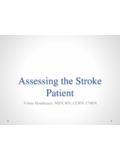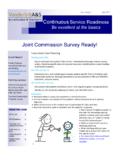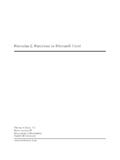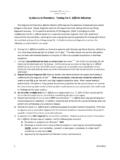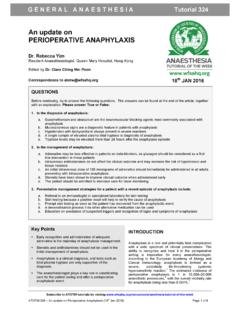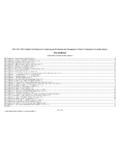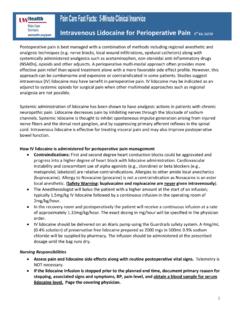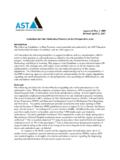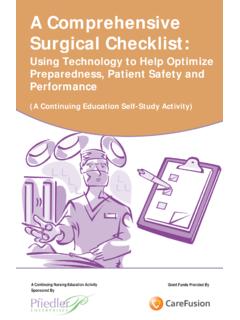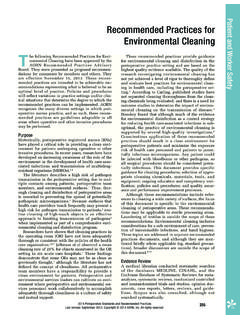Transcription of Manual: Perioperative Services Policy Manual
1 Policy Title/Number: DRESS CODE IN THE OPERATING ROOM # AS Manual : Perioperative Services Policy Manual Categories: Contributors: Review Responsibility: Perioperative Services Policy Committee Effective Date: 9/1981 Last Revised Date: 10/2008 Team Members Performing: RN LPN Care Partner/Patient Care Technician Other licensed staff (specify): Other non-licensed staff (specify): Guidelines Applicable to: VUH VMG* VCH PHV x Other (specify): All Perioperative Services Areas Exceptions (specify): *includes satellite sites unless otherwise specified.
2 Guidelines Applicable to: All patient care areas All inpatient areas Adult areas only Pediatric areas only Critical Care/Stepdown areas only Selected areas (specify): Exceptions (Specify): Specific Education Requirements: Yes No (If yes on specific education, must provide specific training [ , unit based competency checklist completed] Delete this message when inserting the type of required training.) Physician Order Requirements: Yes No DRESS CODE IN THE OPERATING ROOM # AS I. Outcome Goal: To achieve optimal health and safety for patients and staff.
3 II. Policy : Surgical attire is worn to promote cleanliness, surgical consciousness and professionalism within the surgical environment. III. Definitions: A. Surgical Attire includes scrub clothes, hair coverings, mask, protective eyewear, and other protective garments, provide a barrier to contamination that may pass from personnel to patient as well as from patient to personnel. B. The following are "area" definitions for Vanderbilt Medical Center surgical areas: 1. Restricted: Operating Rooms, Main and VCH Operating Room Core. 2. Semi-Restricted: Hallways within the surgical suite (which are not located where open sterile supplies or scrubbed persons may be located) and Medical Center East Core and The Vanderbilt Clinic Core (TVC) 3.
4 No Restrictions: The Control Room(Areas allowing street clothes) Charge Nurse Office, Recovery Rooms, Holding Rooms, Staff Lounges, VCH Control IV. Procedures: A. Identification: A identification badge, with the employees photograph and appropriate title, will be worn by each employee while on hospital premises. This ID badge should in no way interfere with patient care nor jeopardize aseptic technique. Identification badges are worn in clear sight above the waist with name, title, and picture clearly visible. CL B. Hygiene: 1. Good personal hygiene shall be observed. The body shall be clean/free of body odor and/or strong fragrances.
5 2. Hand washing or hospital approved disinfectant is required between patients and when they become soiled or when gloves have been removed. 3. Fingernails are kept clean, well cared for, and no longer than inch from fingertip in length. Artificial and long natural fingernails are not permitted for those providing direct patient care. The definition of artificial fingernails includes, but is not limited to, acrylic nails, all overlays, tips, bondings, extensions, tapes, inlays, and wraps. Nail jewelry is not permitted. Nail polish, if worn, is well maintained. Chipped nail polish is not allowed. CL C. Personal Protection Equipment: 1.
6 Hats/head covers: All head and facial hair must be completely covered. All cloth hats must be covered with a disposable hair cover. All disposable head covers will be removed when leaving the operating room suite. 2. Masks: Disposable masks must be worn in restricted areas and applied to prevent "venting". The mouth and nose should be completely covered. Masks should be changed when they become moist or soiled or if leaving the suite and restricted area. 3. Shoe Covers:. Fluid-resistant shoe covers should be worn when it is anticipated that splashes or spills may occur. If shoe covers are worn, they should be changed whenever they become torn, wet, or soiled, and they should be removed and discarded in a designated container before leaving the surgical area.
7 4. Eyewear and Gloves: Gloves and protective eyewear or face shields shall be worn by all operating room personnel when performing duties that require direct patient contact or contact with contaminated items. Gloves and protective eyewear should be changed after such contacts and before exiting the room. D. Clothing and Personal Articles: 1. Personal clothing worn to and from work should be consistent with hospital Policy CL Scrub attire must not be worn arriving or departing from the hospital grounds. 2. Jewelry: All scrub personnel entering the semi-restricted and restricted areas of the surgical suite are required to have all jewelry removed or confined, including dangle earrings or large beaded/dangle necklaces.
8 3. Cloth Hats: All cloth hats must be covered with a disposable head cover. Cloth hats must be laundered daily. 4. Scrubs: All persons entering semi-restricted and restricted areas of the operating room must be dressed in clean Vanderbilt surgical attire. (Attire from institutions other than Vanderbilt Medical Center is prohibited.) Scrub clothes must be clean at all times. They are to be changed when soiled by blood, body fluids, excessive betadine, food or following documented isolation cases. 5. Tops: A short sleeve t-shirt may be worn by all personnel under scrub tops. Long sleeve tops may not be worn when scrubbed, but may be worn by non-scrubbed personnel if covered by a clean scrub jacket.
9 6. Jackets: a. Only warm up jackets provided by hospital linen Services are allowed in the restricted/semi-restricted areas. This is the only jacket approved to be worn in the restricted and semi-restrictive areas and must be laundered daily. This jacket can not be worn outside the restricted/semi-restricted area. Heavier jackets made for the operating room may be worn if they are covered by a clean warm up jacket. b. A cover garment such as a clean lab coat or personal warm-up jacket other than the one worn in the restricted/semi-restricted area is required to be worn when leaving the restricted/semi-restricted peri-operative areas to protect the scrub clothes from becoming soiled.
10 The cover garment must be removed before reentering a restricted/semi-restricted area. 7. Shoes: Shoes worn within the surgical environment should be clean with no visible soiling and should provide protection. Open-toe shoes should not be worn. Vented shoes should be covered by fluid-resistant shoe covers when it is anticipated that splashes or spills may occur. E. Home laundering of scrub attire is not allowed. All scrubs worn in the OR must be the property of Vanderbilt Hospital and laundered by the hospital laundry. Staff not participating in direct patient care follows the VUMC dress code Policy ( ). Those with possible sensitivity allergies should report to Occupational Health.
